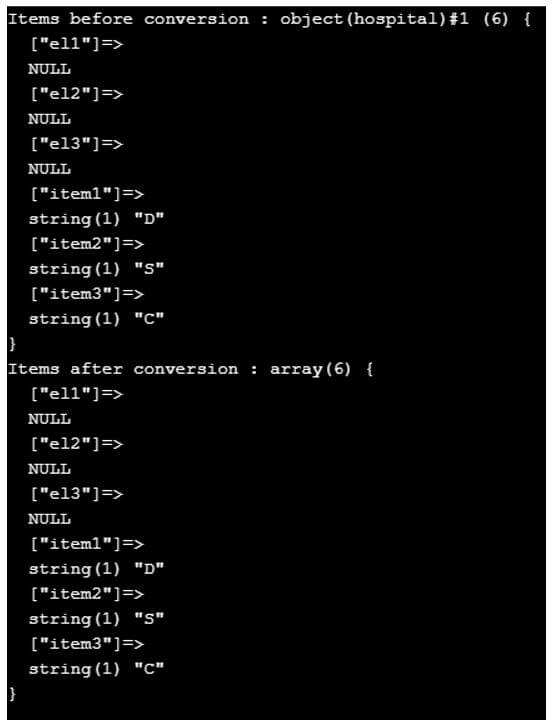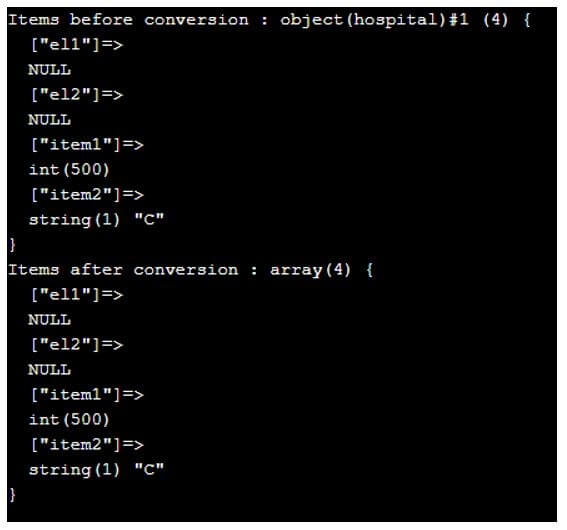PHP object to array
The following article provides an outline for PHP object to array. As we all know, object is known as a class instance which has memory allocated. In the case of an array, it is a data structure containing one or more values of a similar type in a single name. On the other hand, an associative array is not like a normal PHP array. An associative array is an array that consists of a string index which stores item values linked with key values other than in order of the linear index.
ADVERTISEMENT Popular Course in this category PHP DEVELOPER - Specialization | 8 Course Series | 3 Mock TestsStart Your Free Software Development Course
Web development, programming languages, Software testing & others
Methods of a PHP object to array
Now, let us see different ways in which we can convert PHP object to array.
Method 1
With the help of the json_decode and json_encode method
In this method, the function json_decode takes JSON encoded string and changes it into a PHP variable, whereas the json_encode function returns a string which is encoded in a json format for a particular value.
Syntax:
$arr = json_decode(json_encode ( $obj ) , true);
Method 2
With the help of type casting
Typecasting is a technique in which one data type variable into the another data type. It is considered as an explicit data type conversion. It can translate a PHP object to an array with the help of typecasting rules in PHP.
Syntax:
$arr = (array) $obj;
How to Convert an object to an array in PHP?
As we all know, there are several formats of data like strings, objects, arrays etc. In the case of PHP also, there are data formats like this. In order to get the needed output, a php object obj result is needed in a format of an associative array.
Now, let us see how to translate a php object.
Code:
<?php
class hospital
{
// elements
. . . .
function __construct( $dis1, $dis2, $dis3)
{
// Use this pointer
. . . .
}
// create class object
. . .
// convert object to array
. . . .
?>This is the skeleton for converting an object into an array.
Now let us see how to perform this.
- In order to encode the string, use “object = json_encode($array);”
When the object is var_dump, all items will be displayed.
- For decoding into an object, a json string which is available will be used to convert and string formatting is done to an object. It will be done using $obj = json_decode(json_encode($arr));
- When the object is var_dump, all items will be displayed after converting into an array.
Here, one important point to consider is json_decode that translates a json string to an object, except you offer another option that is boolean which can be true or false. Even if the second parameter is considered as true, an array will be obtained.
Also, when json encode operation and decode operation are used, arrays are converted to objects that take up many resources if the array is large. In that case, the better method to type cast an array to an object that uses the object cast.
Consider $obj = (object) $arr; syntax. Here also, object will be converted into arrays.
Based on the requirements, you can choose the method you want for the conversion of an array into an object in PHP.
Examples of a PHP object to array
Different examples are mentioned below:
Example #1
PHP program to convert an object to an array using the typecasting method.
Code:
<?php
class hospital
{
var $el1;
var $el2;
var $el3;
function __construct( $dis1, $dis2, $dis3)
{
$this->item1 = $dis1;
$this->item2 = $dis2;
$this->item3 = $dis3;
}
}
// Creation of object for the class
$dis = new hospital("D", "S", "C") ;
echo "Items before conversion : " ;
var_dump($dis);
// convert object to array
$arr = (array)$dis;
echo "Items after conversion : ";
var_dump($arr);
?>Output:

In this program, a class hospital is created, and inside that, three elements such as el1, el2, and el3. Then, a __construct() function is declared, which gets executed during the time object is created. Once this is done, the constructor takes parameters that are later offered during the object creation using the keyword “new”. From the program, it can be seen that objects get printed in the first case of expression var_dump(). But in the second case of expression, an object is casted into an array using the typecasting procedure.
Example #2
PHP program to convert an object to an array using json encode and json decode.
Code:
<?php
class hospital
{
var $el1;
var $el2;
function __construct( $dis1, $dis2 )
{
$this->item1 = $dis1;
$this->item2 = $dis2;
}
}
// Creating object
$dis = new hospital(500, "C");
echo "Items before conversion : " ;
var_dump($dis);
// convert object to array
$arr = json_decode(json_encode($dis), true);
echo "Items after conversion : ";
var_dump($arr);
?>Output:

In this program also, a class hospital is created, and inside that, two elements such as el1 and el2, are created. Then, a __construct() function is declared, which gets executed during the time object is created. Once this is done, the constructor takes parameters that are later offered during the object creation using the keyword “new”. From the program, it can be seen that objects get printed in the first case of expression var_dump(). But in the second case of expression, an object is casted into an array using the typecasting procedure. Here, the first method in the method sections is used for converting an object into an array.
Conclusion
An associative array is an array that consists of a string index which stores item values linked with key values other than in order of the linear index. This article saw how PHP object to array is working, methods to achieve it, and different examples.
The above is the detailed content of PHP object to array. For more information, please follow other related articles on the PHP Chinese website!

Hot AI Tools

Undresser.AI Undress
AI-powered app for creating realistic nude photos

AI Clothes Remover
Online AI tool for removing clothes from photos.

Undress AI Tool
Undress images for free

Clothoff.io
AI clothes remover

AI Hentai Generator
Generate AI Hentai for free.

Hot Article

Hot Tools

Notepad++7.3.1
Easy-to-use and free code editor

SublimeText3 Chinese version
Chinese version, very easy to use

Zend Studio 13.0.1
Powerful PHP integrated development environment

Dreamweaver CS6
Visual web development tools

SublimeText3 Mac version
God-level code editing software (SublimeText3)

Hot Topics
 1379
1379
 52
52
 PHP 8.4 Installation and Upgrade guide for Ubuntu and Debian
Dec 24, 2024 pm 04:42 PM
PHP 8.4 Installation and Upgrade guide for Ubuntu and Debian
Dec 24, 2024 pm 04:42 PM
PHP 8.4 brings several new features, security improvements, and performance improvements with healthy amounts of feature deprecations and removals. This guide explains how to install PHP 8.4 or upgrade to PHP 8.4 on Ubuntu, Debian, or their derivati
 How To Set Up Visual Studio Code (VS Code) for PHP Development
Dec 20, 2024 am 11:31 AM
How To Set Up Visual Studio Code (VS Code) for PHP Development
Dec 20, 2024 am 11:31 AM
Visual Studio Code, also known as VS Code, is a free source code editor — or integrated development environment (IDE) — available for all major operating systems. With a large collection of extensions for many programming languages, VS Code can be c
 7 PHP Functions I Regret I Didn't Know Before
Nov 13, 2024 am 09:42 AM
7 PHP Functions I Regret I Didn't Know Before
Nov 13, 2024 am 09:42 AM
If you are an experienced PHP developer, you might have the feeling that you’ve been there and done that already.You have developed a significant number of applications, debugged millions of lines of code, and tweaked a bunch of scripts to achieve op
 How do you parse and process HTML/XML in PHP?
Feb 07, 2025 am 11:57 AM
How do you parse and process HTML/XML in PHP?
Feb 07, 2025 am 11:57 AM
This tutorial demonstrates how to efficiently process XML documents using PHP. XML (eXtensible Markup Language) is a versatile text-based markup language designed for both human readability and machine parsing. It's commonly used for data storage an
 Explain JSON Web Tokens (JWT) and their use case in PHP APIs.
Apr 05, 2025 am 12:04 AM
Explain JSON Web Tokens (JWT) and their use case in PHP APIs.
Apr 05, 2025 am 12:04 AM
JWT is an open standard based on JSON, used to securely transmit information between parties, mainly for identity authentication and information exchange. 1. JWT consists of three parts: Header, Payload and Signature. 2. The working principle of JWT includes three steps: generating JWT, verifying JWT and parsing Payload. 3. When using JWT for authentication in PHP, JWT can be generated and verified, and user role and permission information can be included in advanced usage. 4. Common errors include signature verification failure, token expiration, and payload oversized. Debugging skills include using debugging tools and logging. 5. Performance optimization and best practices include using appropriate signature algorithms, setting validity periods reasonably,
 PHP Program to Count Vowels in a String
Feb 07, 2025 pm 12:12 PM
PHP Program to Count Vowels in a String
Feb 07, 2025 pm 12:12 PM
A string is a sequence of characters, including letters, numbers, and symbols. This tutorial will learn how to calculate the number of vowels in a given string in PHP using different methods. The vowels in English are a, e, i, o, u, and they can be uppercase or lowercase. What is a vowel? Vowels are alphabetic characters that represent a specific pronunciation. There are five vowels in English, including uppercase and lowercase: a, e, i, o, u Example 1 Input: String = "Tutorialspoint" Output: 6 explain The vowels in the string "Tutorialspoint" are u, o, i, a, o, i. There are 6 yuan in total
 Explain late static binding in PHP (static::).
Apr 03, 2025 am 12:04 AM
Explain late static binding in PHP (static::).
Apr 03, 2025 am 12:04 AM
Static binding (static::) implements late static binding (LSB) in PHP, allowing calling classes to be referenced in static contexts rather than defining classes. 1) The parsing process is performed at runtime, 2) Look up the call class in the inheritance relationship, 3) It may bring performance overhead.
 What are PHP magic methods (__construct, __destruct, __call, __get, __set, etc.) and provide use cases?
Apr 03, 2025 am 12:03 AM
What are PHP magic methods (__construct, __destruct, __call, __get, __set, etc.) and provide use cases?
Apr 03, 2025 am 12:03 AM
What are the magic methods of PHP? PHP's magic methods include: 1.\_\_construct, used to initialize objects; 2.\_\_destruct, used to clean up resources; 3.\_\_call, handle non-existent method calls; 4.\_\_get, implement dynamic attribute access; 5.\_\_set, implement dynamic attribute settings. These methods are automatically called in certain situations, improving code flexibility and efficiency.




